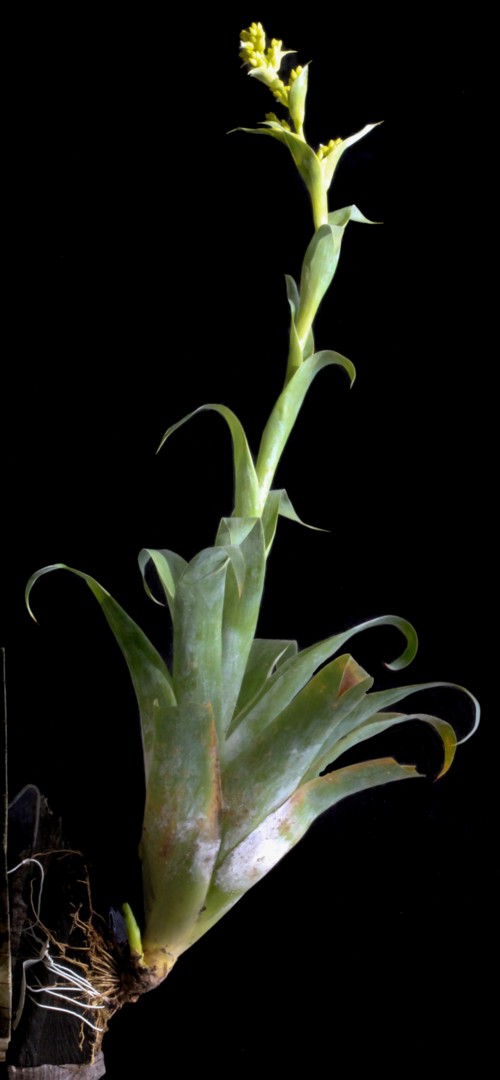
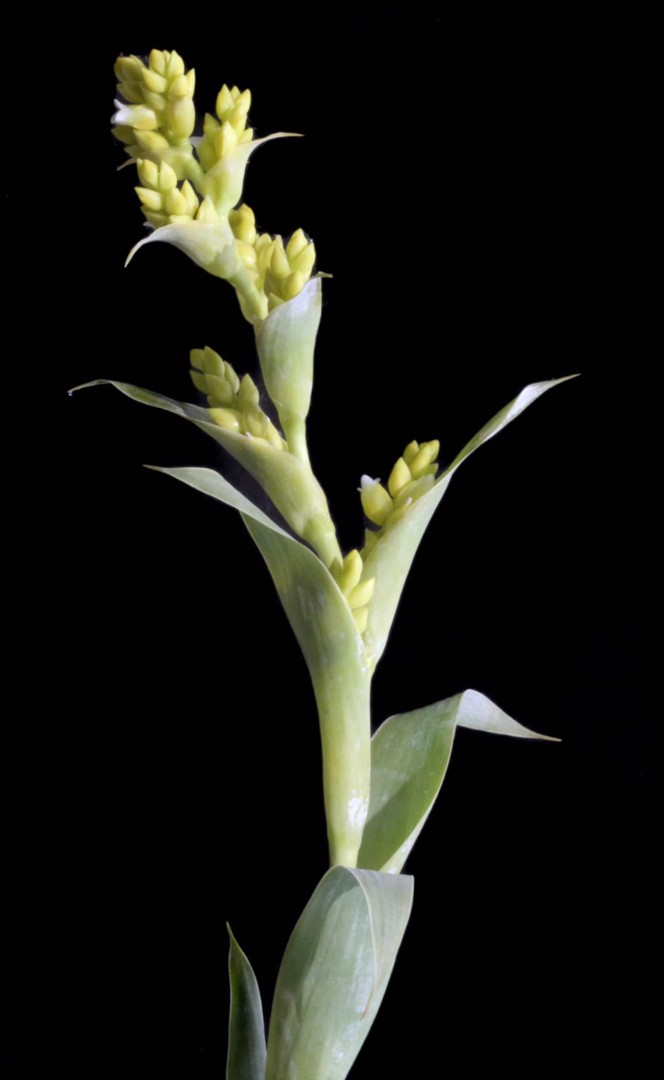
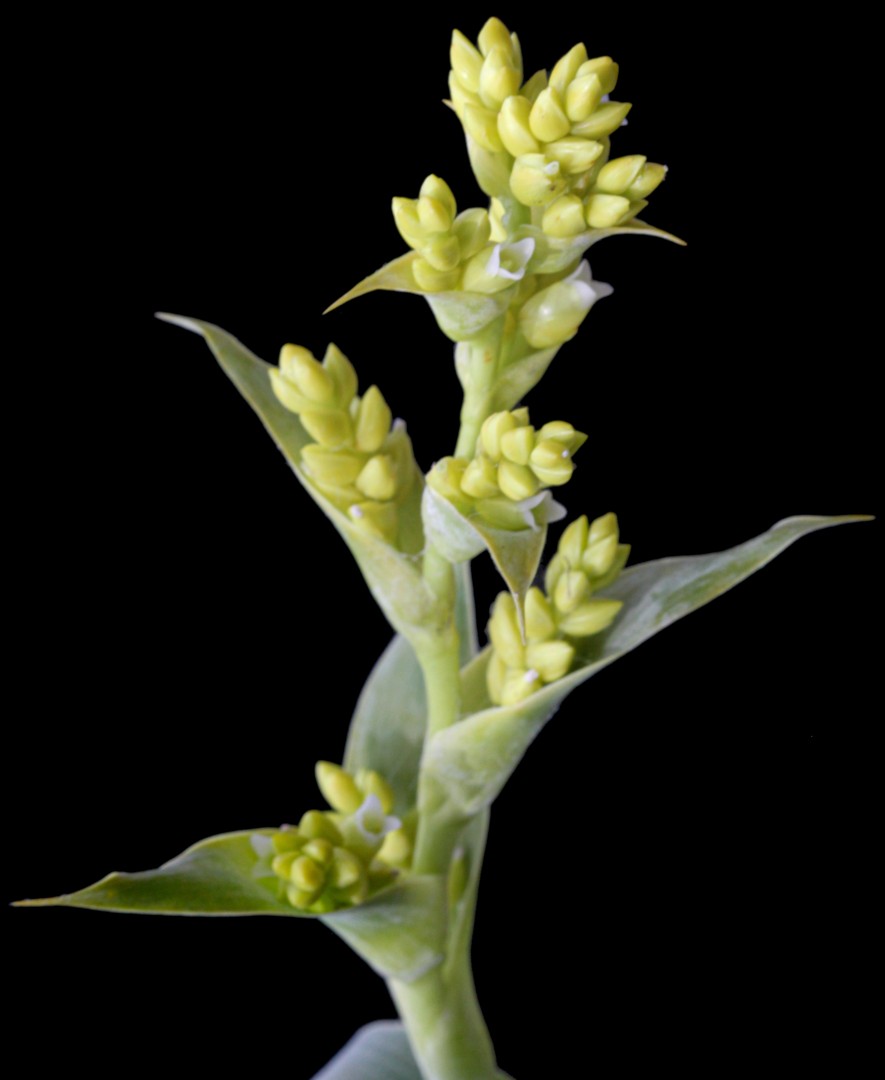
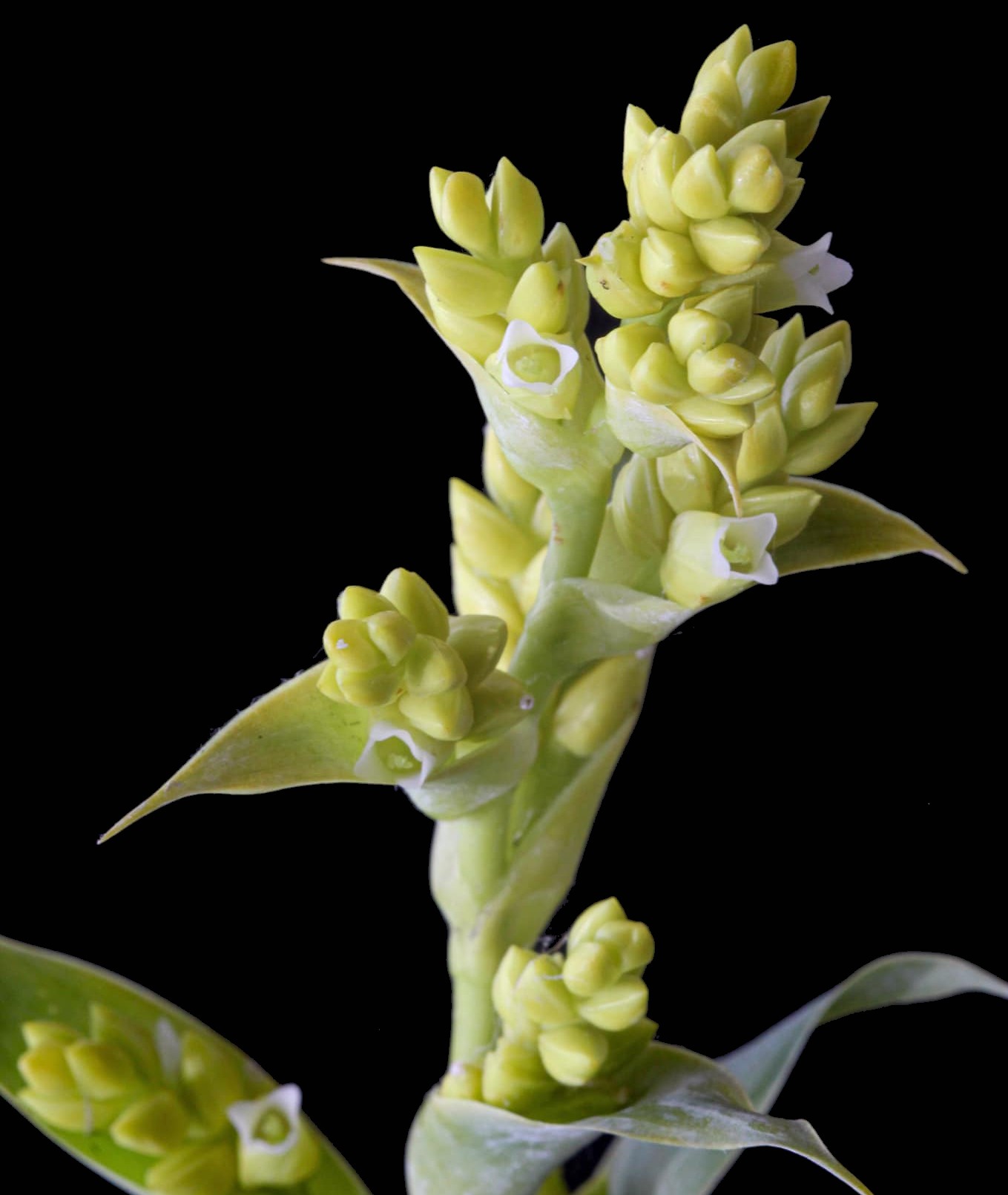
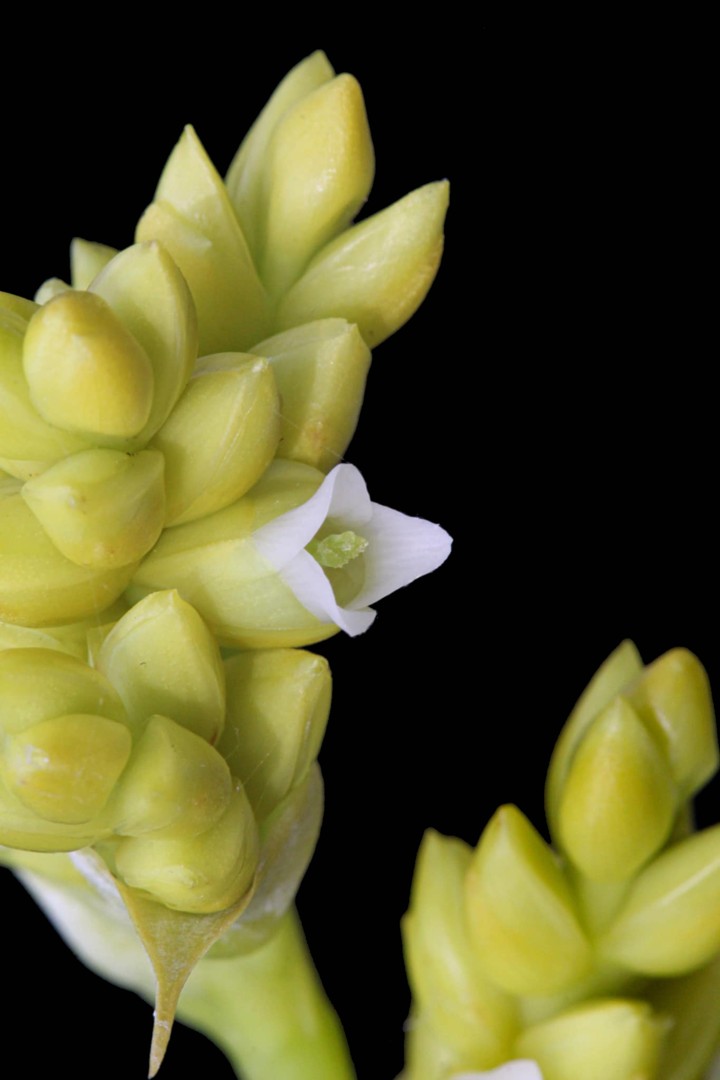
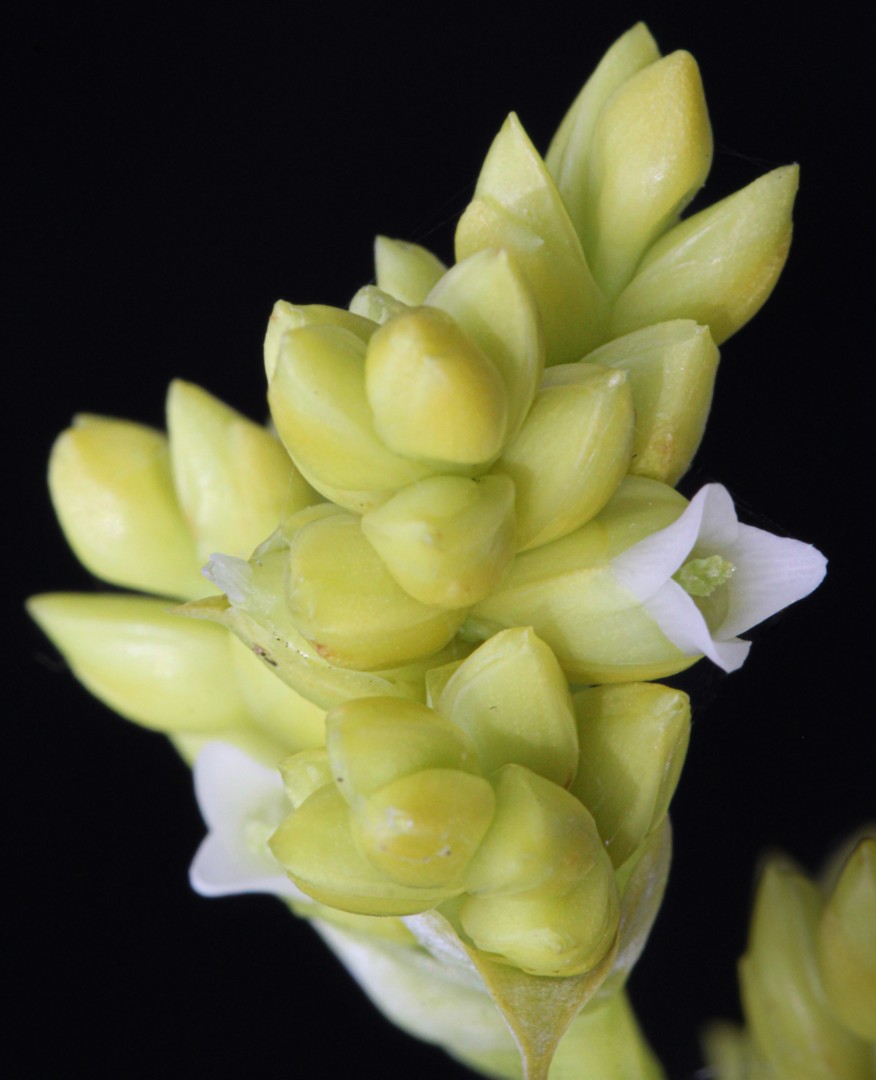
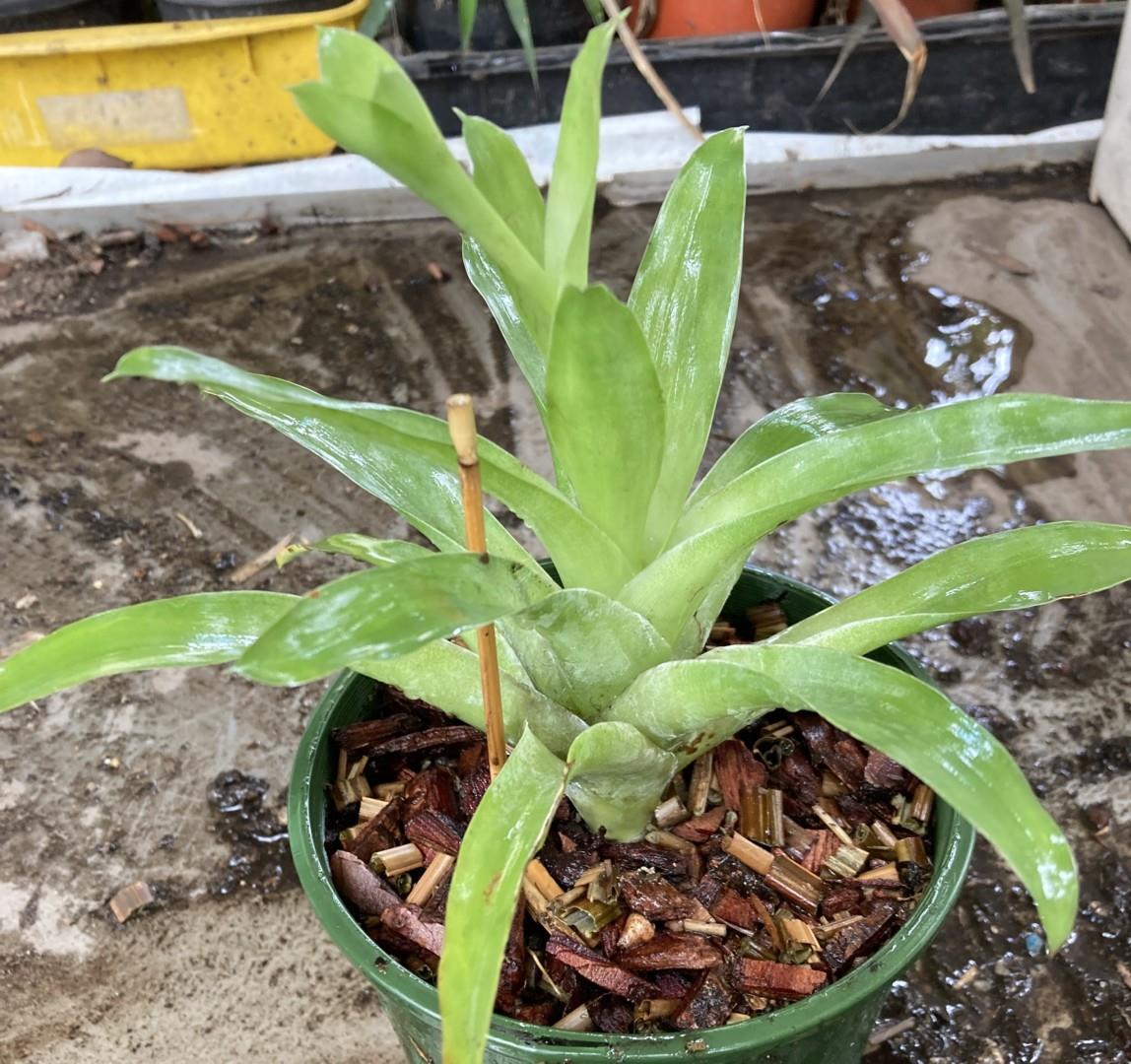
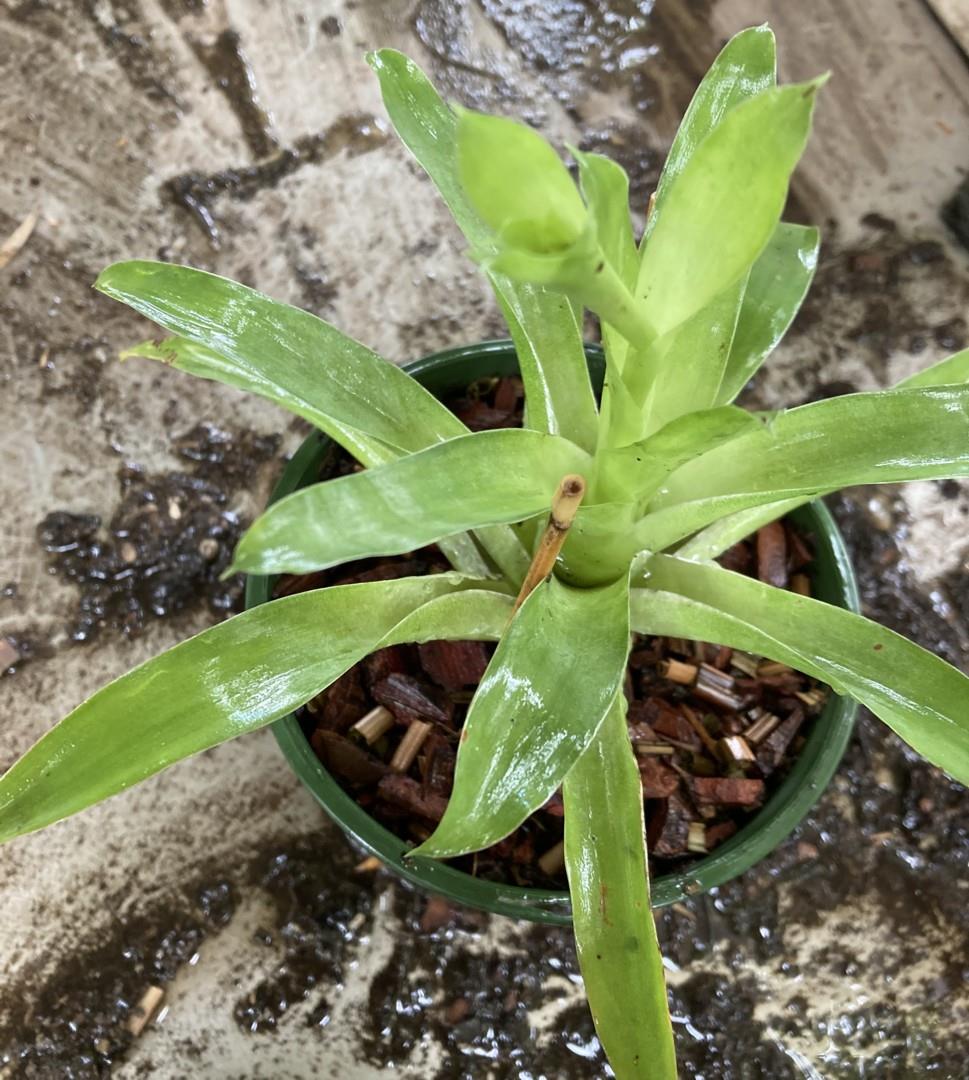
Holotype: Hahn 587, Mexico, Jalapa, Veracruz,1865-1866; P? n.v.; isotype K!, staminate plant.
desc from Palaci 1997
Plants in flower (20) 25-40 (80) cm, dioecious, staminate plants usually smaller, but vegetatively similar to pistillate plants.
Leaves in a subfasciculate rosette, broadly lanceolate, (11) 20-30 (40) cm long, olivaceus green, with narrow yellowish margins, usually with abundant chalk-like epicuticular waxes especially towards the base;
leaf blades triangular to narrowly triangular, 1-2.5 cm wide, the apex long-attenuate, acuminate;
leaf sheaths indistinct, widely elliptic, (7) 10-15 (30) x (2) 4-7 cm, 1-4 times wider than the blades.
Scape erect or suberect;
scape bracts densely imbricate, the lower ones foliaceous, narrowly triangular, much longer than the internodes, the apex long-attenuate, acuminate.
Inflorescence erect, once or twice pinnate, 6-30 cm long, with 4-10 (22) spikes;
lower primary bracts yellowish green, broadly ovate-lanceolate, the apex long-attenuate, acuminate, (2) 6-10 (14) x (1) 1.5-3 cm, much longer than the spikes, or very rarely ~ equalling the spike length;
spikes erect to spreading, short-stipitate, 3-5 (13)cm long, densely flowered, with ca. 6-12 (18) flowers per spike.
Flowers functionally unisexual, sessile.
Pistillate flowers:
floral bracts deltate, (5) 6-8 x 5-7 mm, 1-3 mm shorter than the sepals, chartaceous, faintly nerved, the apex obtuse, the margins narrowly hyaline;
sepals yellowish-green, asymmetric, elliptic to widely elliptic, 6-8 x 4-6.5 mm, chartaceous to subcoriaceous, smooth and faintly nerved, carinate, the apex obtuse;
petals white, triangular to narrowly triangular, 6-7 (8) x 4-6 (7) mm, slightly exceeding the sepals.
Staminate flowers:
floral bracts widely elliptic to deltate, (3.5) 5-7 x 4-6 mm, 1-2 mm shorter than the sepals, membranaceous, faintly nerved, the apex obtuse, the margins very narrowly hyaline;
sepals as in pistillate flowers, 5-7 x 4-6 mm;
petals white, 4.5-7 x 2-3 mm, slightly exceeding the sepals.
Capsules ovoid, short-beaked, 9.5-13 (15) x 4-7 mm.
Pine-oak forests, lower mountain forests and rain forests, 400-2700 m; s. Mexico, Belize, Guatemala, El Salvador, Honduras and Nicaragua.
Plants of C. hahnii are relatively variable in size; infrequent large plants are occasionally found in wet, undisturbed forests. The yellowish-green color of the inflorescence bracts and flowers makes this species of ornamental interest. Plants of C. hahnii are frequently sold in local markets in Guatemala city.
Material examined: see appendix.
Catopsis hahnii Baker, Jour. Bot. London 25: 175. 1887.
Catopsis oerstediana Mez, DC. Monogr. Phan. 9: 630. 1896. Type. Volcan El Viejo, Guanacaste, Costa Rica, Oersted 18 (C, F photo 22325).
Desc from S&D
Plant flowering over 5 dm high.
Leaves to 4 dm long, often bearing a slight cretaceous coat on the back;
sheaths elliptic, as long as or longer than the blades;
blades triangular, to 45 mm wide.
Scape erect or arching;
scape-bracts foliaceous, densely imbricate.
Inflorescence bipinnate or subtripinnate, narrow, 10-25 cm long, dense toward apex;
primary bracts nearly equaling to exceeding the lower branches, ovate-lanceolate, acuminate;
spikes densely cylindric, to 45 mm long.
Floral bracts ovate-elliptic, obtuse, 6 mm long, shorter than the sepals;
flowers suberect, perfect (?) or unisexual.
Sepals asymmetric, 7-9 mm long, concolorous;
petals barely exceeding the sepals, white.
TYPE: Hahn 587 (holotype P), Jalapa, Vera Cruz, Mexico.
DISTRIBUTION. Epiphytic in forest, 1200-2700 m alt, southern Mexico, Central America.
MEXICO. OAXACA: Talea, Galeotti 4919 (BR); Teotalcingo, Liebmann 42 (C); Portillo de Coyula, Cuicatlan, 10 Nov 1919, Conzatti 3870 (US). CHIAPAS: Saxchanal, Sierra Madre, 1 Jul 1941, Matuda 4319 (GH, LL, US); Monte Bello, Jan 1952, Carlson 2375 (US); Aug 1965, Roe & Mori 976 (US, WIS); 17 Aug 1966, Breedlove 14990 (US). GUATEMALA. QUICHE: San Pedro Jocopilas to Quiche, 12 Jan 1939, Standley 62464 (F); Nebaj, Rio de las Violetas Valley, 21 Jul 1964, Proctor 25201 (LL): HUEHUETENANGO: Aguacatan to Huehuetenango, 2 Jan 1941, Standley 81932 (F); 82014 (F); Mimanhuitz to Yulhuitz, Sierra de los Cuchumatanes, 14 Jul 1942, Steyermark 48624. (F); Xorlac to Nucapuxlac, 17 Ju1 1942, Steyermark 48917 (F, GH); Carrizal, 17 Aug 1942, Steyernzark 50823 (F, GH). ALTA VERAPAZ: Tactic, 14 Apr 1941, Standley 92353 (F); 92408 (F); 92638 (F); 20 Feb 1942, Steyermark 44013 (F). SAN MARCOS: San Marcos to San Rafael Pie de la Cuesta, 6 Feb 1941, Standley 86486 (F). CHIMALTENANGO: San Martin Jilotepeque to Chimaltenango, 3 Feb 1939, Standley 64502 (F). SOLOLA: Volcan Atitlan, 11 Jun 1942, Steyermark 47394 (F). HONDURAS. COMAYAGUA: El Achote, Siguatepeque, 21 Jul 1936, Yuncker, Dawson & Youse 6026 (GH). MORAZAN: Cerro de Uyuca, 7 Aug 1946, Williams & Molina 10268 (GH); 5 Dec 1946, Allen 4001 (MO); Standley & Williams 103-A (F, US); 15 Jul 1964, Molina 14558 (EAP, F, US). SALVADOR. SANTA ANA: Hacienda Montecristo, 7 Jun 1951, Rohweder 451-452 (HBG); Hacienda Los Planes, 453-463 (HBG); 25 Aug 1951, 464 (HBG). NICARAGUA. MATAGALPA: San Ramon to Bavaria Finca, 1963, Heller s n (F). JINOTEGA: Ocotillo, Santa Lastenia, 17 Jan 1965, Williams et al 27788 (EAP, F, US).
From Mez 1935
Protologue
23. C. Oerstediana Mez in DC. Monogr. Phaner. IX. (1896) 630.
Paullo ultra 0.4.m alta. Folia multa, ad 0.15 m longa, super vaginam ad 45 mm lata inde in apicem angustata subtriangularia, haud cretacea. Scapus erectus, vaginis internodia longe superantibus involutus. Inflorescentia submultiflora, 2-pinnatim panniculata, densissime e spicis abbreviatis composita, subclavata, ad 0.11 m longa et 35mm diam. metiens; bracteis primariis inferioribus mediisque saltem ramulos axillares superantibus, omnino foliaceis et vaginis scapalibus isomorphis; ramulis stricte erectis, medium usque sterilibus tunc florum ad 7 spicam densissimam gerentibus; bracteis florigeris quam sepala permanifeste brevioribus, ovato-ellipticis, rotundatis, ad 6 mm longis. Flores (masculi ignoti) suberecti, ad 9mm longi; sepalis valde asymmetricis, quam petala brevioribus, posticis 2 obtuse carinatis, latissime ellipticis, rotundatis, subcoriaceis, ad 8 mm longis. Petala alba, sub-orbicularia. Stylus subnullus.
Costarica: Gipfel des Berges El Viejo (Oersted n. 18).
Catopsis oerstediana Mez, DC. Monogr. Phan. 9:630, 1896;
13, C. Oerstediana; foliis apicem versus sensim peracutis; scapo erecto vaginis internodia longe superantibus involuto; inflorescentia bipinnatim panniculata, bracteis primariis inferioribus mediisque saltem ramulos axillares superantibus, bracteolis florigeris quam sepala permanifeste brevioribus; floribus dioicis, male ignotis; sepalis valde asymmetricis, quam petala brevioribus, stylo subnullo.
Florifera paullo ultra 0.4 m. alta. Folia 20-25, ad 0.25 m. longa, super vaginam ~45 mm. lata inde in apicem angustata subtriangularia, haud cretacea. Inflorescentia submultiflora, densissime e spicis abbreviatis composita, subclavata, ~11 m. longa, 35 mm. diam. metiens; ramulis stricte erectis rnedium usque sterilibus tum florum ~7 spicam densissimam gerentibus, usque ad 45 mm. longis; bracteis primariis omnino foliaceis vaginisque scapalibus isomorphis, suberectis; bracteolis florigeris chartaceis, glabris, dorso minute solum prominulo-venosis, ovato-ellipticis, apice optime rotundatis, ~6 mm. longis. Flores suberecti, ad 9 mm. longi; sepalis ex sicco luteis vel luteo-virentibus, subcoriaceis, dorso glabris laevibusque, posticis binis conspicue obtuse carinatis, latissime ellipticis, latere tecto in alam maximam, apieem obtusum longe superantem dilatatis, ~8 mm. longis. Petala alba, suborbicularia apice rotundata. Stamina in floribus female solum suppetentibus valde reducta antheris minutis, subsagitiformibus, hyalino-pellucidis, sterilibus. Ovarium in flore ♀ maximum, crasse ovoideum.
Costariea in montis El Viejo regionibus summis: Oersted Brom. n. 18. (V. s. in herb. Haun.)